Foreword by your authors
Misho and I had always been drawn to its mix of old-world charm and modern hustle. On our first day, we decided to explore the historic Upper Town, with its cobblestone streets and medieval towers.
As we wandered, we found ourselves in front of the famous Stone Gate. Drawn by the flickering candles inside, we stepped in to pay our respects. Just as I was lighting a candle, I accidentally knocked over Misho’s backpack, spilling its contents everywhere. Among the scattered items was a small, antique-looking compass his grandfather had given him. Before we could react, a street cat playfully swatted the compass, sending it rolling down the street.
Chasing after it, we were led to a hidden courtyard where a group of locals were enjoying a spontaneous acoustic jam session. Seeing our breathless state, they invited us to join. With the compass safely back in Misho’s hands, we spent the evening singing, dancing, and sharing stories under the Zagreb sky.
That unexpected turn in Zagreb not only reunited Misho with his cherished compass but also introduced us to the city’s soulful spirit and the warmth of its people.
Quick Intro
Welcome to Zagreb, the vibrant capital of Croatia! Situated in the northwest of the country, Zagreb is full of life. It’s a city that offers something for everyone – whether you’re looking for a cultural break or an action-packed adventure.
From its stunning architecture to its lively nightlife scene, this city has plenty to offer travelers. The city boasts a variety of attractions, ranging from galleries and museums to parks and churches.
Me and Mile try to visit this city once in a year, and to be fair, it’s not fair to do it just once!
Zagreb is a unique and dynamic city full of culture, history, and art. Located in the heart of Central Europe, Zagreb is a vibrant city with plenty of attractions to explore. From its stunning architecture to its thriving nightlife, there’s something for everyone in this dynamic city.
It’s known as the “City of Museums” due to its many galleries and cultural institutions that are sure to delight visitors.
From the historic Old Town to its modern skyscrapers, Zagreb has something for everyone.
Located in the heart of Europe, Zagreb is one of the oldest cities on the continent and was an important cultural hub since its founding in 1094.
Let’s go through the best things to do in Zagreb and get back to traveling!
10 Tips Travelers Should Know When Visiting Zagreb
If you’re charting a course to Croatia’s capital, here are 10 tips from Misho’s and my adventures:
- Historic Exploration: Don’t miss the Upper Town (Gornji Grad) with its medieval charm, the iconic St. Mark’s Church, and the Lotrščak Tower. Time your visit to hear the Gric Cannon fire at noon!
- Museums: Zagreb boasts a plethora of museums. The quirky Museum of Broken Relationships and the impressive Mimara Museum are must-visits.
- Local Cuisine: Dive into Croatian flavors with dishes like “štrukli” (cheese-filled pastry) or “purica s mlincima” (roast turkey with special pasta). And Misho? He can’t resist the local pastries!
- Public Transport: The city’s tram system is efficient and covers most tourist attractions. Grab a daily pass if you plan to hop on and off multiple times.
- Dolac Market: Experience the local vibe at this bustling farmers’ market. From fresh produce to artisanal cheeses, it’s a feast for the senses.
- Zagreb Eye: For a panoramic view of the city, head to the Zagreb Eye observation deck. It’s especially magical during sunset.
- Festivals: Zagreb hosts various events year-round, from the Christmas Market (voted Europe’s best multiple times) to the INmusic Festival in summer.
- Maksimir Park: This is Zagreb’s largest park and a perfect spot for relaxation, picnics, or a leisurely stroll among lakes and forests.
- Local Etiquette: Croatians are warm and friendly. A simple “Hvala” (Thank you) or “Dobar dan” (Good day) in Croatian can go a long way.
- Day Trips: Zagreb’s central location makes it ideal for day trips. Consider visiting the Plitvice Lakes National Park or the picturesque town of Samobor.
Ok, time to jump into the amazing things to see in Zagreb.
Museum of Broken Relationships
Ćirilometodska ul. 2, 10000, Zagreb, Croatia || every day 10 AM – 9 PM
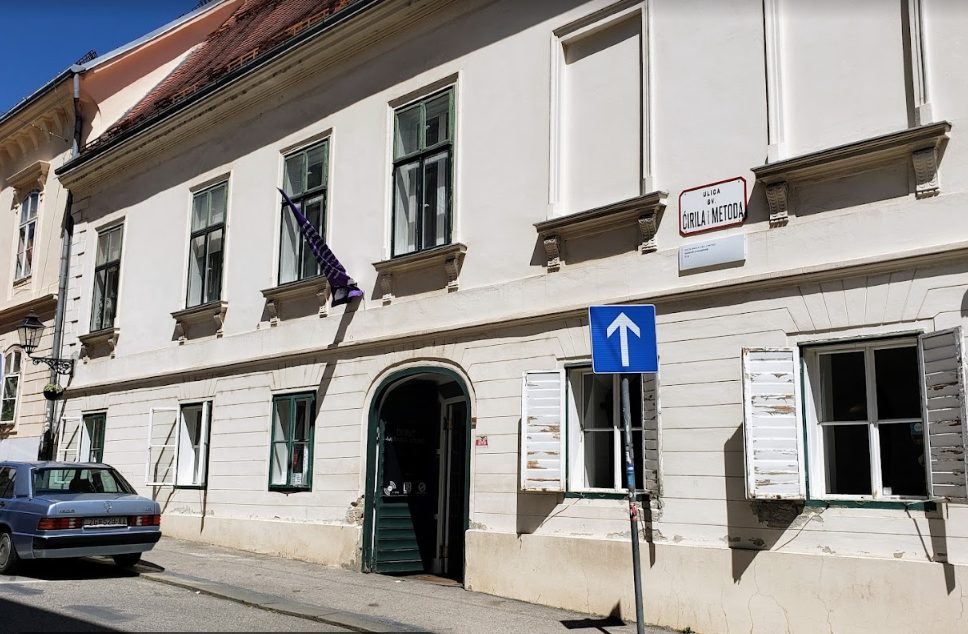
The Museum of Broken Relationships offers an intimate and unique experience to visitors looking to reflect on the complexities of love.
Founded by film producer Olinka Vištica and sculptor Dražen Grubišić, this museum takes a creative approach to the universal topic of breakups.
Btw, if you’d like to skip the line and avoid waiting, take this tour here.
Within its walls lies an eclectic collection of objects that were donated anonymously by those whose hearts broke. From poignant handwritten letters to heartfelt mementos, each object serves as a reminder that while sorrowful, heartache is something we can all identify with.
The museum also plays host to a number of special exhibits from time to time. Whether it is live performances or interactive installations, these exhibitions offer fresh perspectives on the trials and tribulations of relationships gone awry.
Brief history
The Museum of Broken Relationships in this capital is a unique exhibition of items that were donated by people from all over the world. Established in 2010, this museum became a place for people to share their stories and express the emotions surrounding their break-ups. It is a place for visitors to contemplate and reflect upon relationships gone wrong.
Croatian artists Olinka Vištica and Dražen Grubišić thought of this museum when they visited Los Angeles in 2006. While there, they stumbled upon an art installation at Hollywood Forever Cemetery with items left behind after failed relationships—items like love letters or photographs that were slowly decaying away over time. Inspired by what they saw, Vištica and Grubišić decided to create something similar back home in Zagreb.
2 fun facts about the museum of broken relationships
- At the gallery, sightseers can take part in hands-on activities like confessions, and place their objects or communications in a confidential and safe area.
- From all corners of the globe, individuals give away personal things that signify a past love affair, frequently alongside a brief account.
Visit St. Mark’s Church
Trg Sv. Marka 5, 10000, Zagreb, Croatia || from Monday to Saturday 7:30 am – 6 pm, and on Sundays 10:30 am – 6 pm
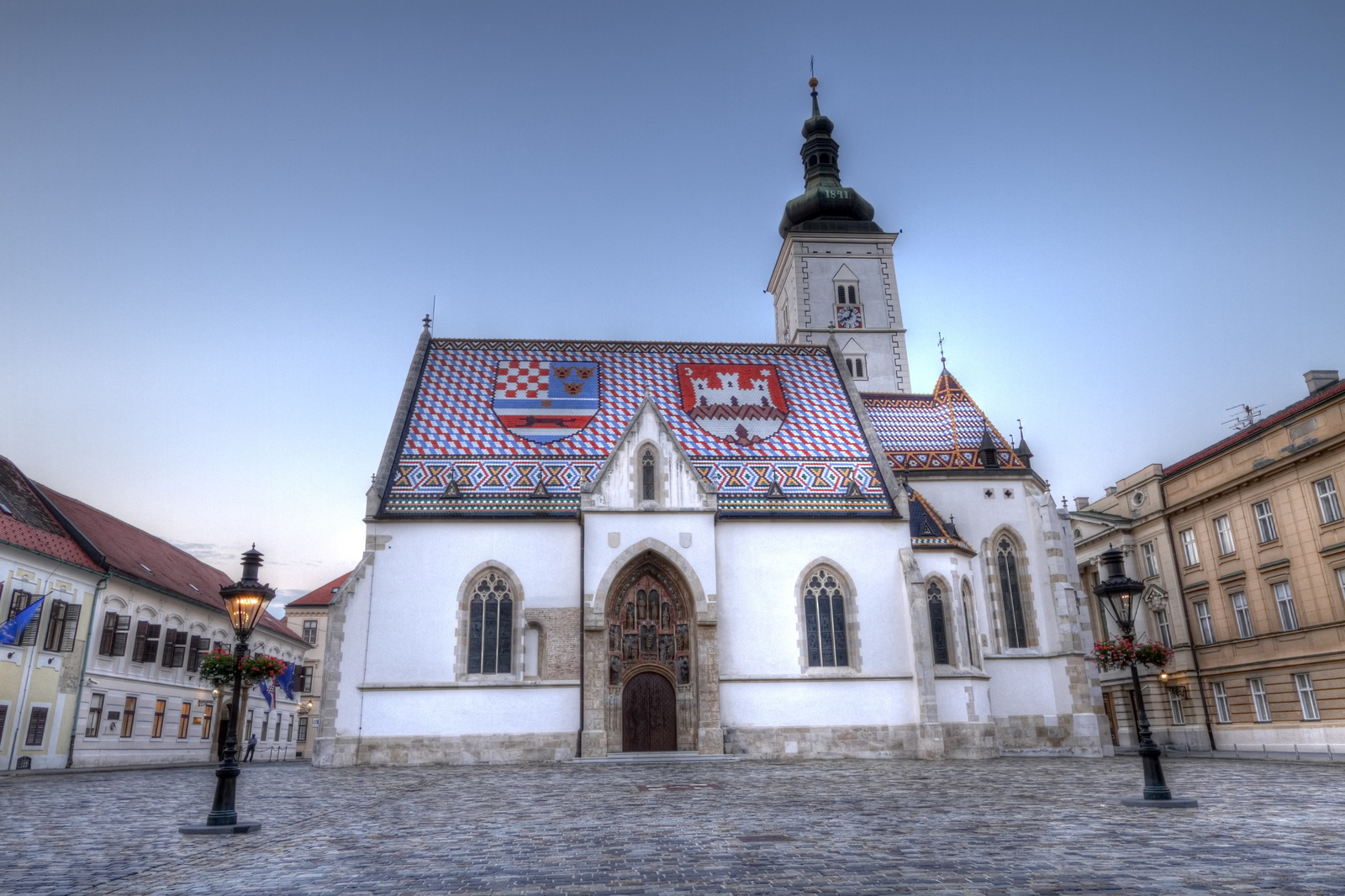
St. Mark Church, located in this capital has a long and unique history. Built-in the 13th century by Croatian King Bela IV as part of his effort to promote Christianity in the region, this cultural monument is considered one of the most important churches in the country`s capital.
Its iconic red-tiled roof and prominent bell tower make it one of Zagreb’s most recognizable landmarks.
The church’s architectural style is Romanesque with gothic influences, evidence of which you can find throughout its interior design.
Inside you will find a noteworthy collection of religious artifacts including an intricately carved wooden crucifix from the 14th century and a painting by renowned artist Luka Radic depicting the Virgin Mary with the Child Jesus surrounded by musical angels playing different instruments.
Brief History
The church was built on the site of an ancient Roman temple dedicated to Mars, the God of War and it was originally called St. Marcus Evangelista Church after its patron saint, Saint Mark.
The exterior walls are decorated with intricate sculptures depicting scenes from the country’s past including national heroes such as Ban Josip Jelačić, who led the country against Austrian forces during the 19th-century revolution. The baroque-style roof is tiled with multicolored tiles manufactured in Venice which makes it stand out from other churches in the capital.
3 fun facts about St. Mark`s church
- The Republic of Croatia safeguards the church as a cultural legacy.
- The Church of St. Mark frequently experienced substantial devastation from tremors and urban blazes, especially its campanile.
- Between World War I and World War II, it is significant to note that this was the time when the inside of the church was decorated with masterpieces by renowned Croatian artists.
Zagreb`s Upper Town
Gornji Grad 10000, Zagreb Croatia
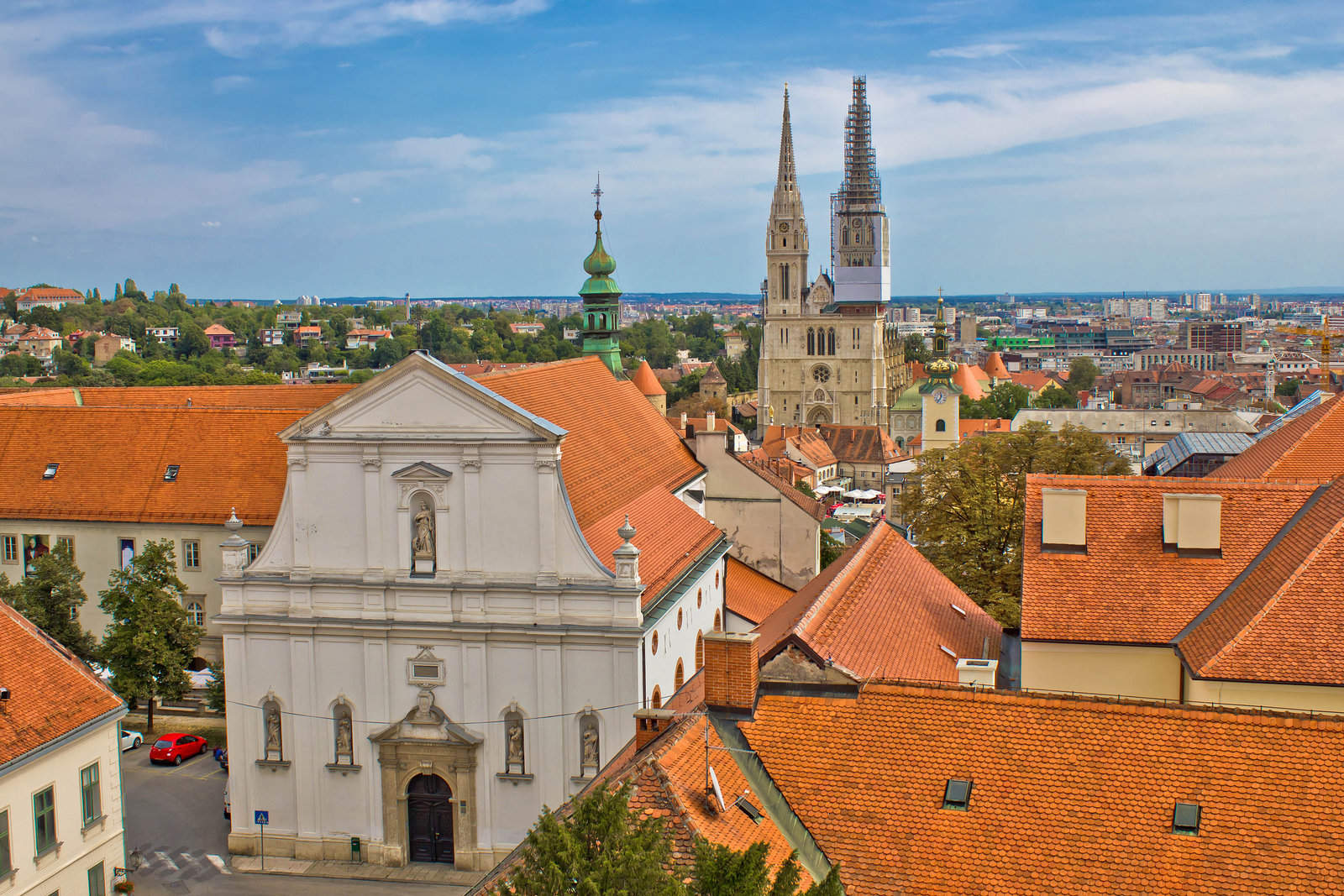
City’s Upper Town is a must-see destination for tourists and locals alike. Located in the center of the city, it is home to some of Zagreb’s most important historical landmarks.
Upper Town stands at the top of Gradec Hill, offering stunning views over the capital. It was an integral part of Zagreb since the 17th century and continues to be a popular tourist attraction due to its well-preserved architecture and old-world charm.
Famous sights include St Mark’s Church, built in 1242 as Croatia’s center for religious life and culture; Kaptol Square, with its iconic statue dedicated to Bishop Gregorius of Nin; Lotrščak Tower which dates back to 1389; and Stone Gate, said to be one of Zagreb’s oldest buildings still standing today.
Brief History
Capital’s Upper Town is a beautiful and historic area in the capital city. It was around since Roman times, and its history is as varied as it is long.
The earliest account of the Upper Town dates back to 1094 when it was founded by King Ladislaus I. Since that time, the region had numerous changes, especially during the rule of the Habsburgs in the late 19th century. During that period, the capital grew rapidly with new architectural styles being introduced.
This led to an expansion of the Upper Town which included many classic buildings such as St Mark’s Church and Stone Gate.
The charming atmosphere of this part of town can attribute to its narrow alleyways and cobblestone streets which lead up from Lower Town towards Lotrščak Tower near Gornji Grad Square.
3 fun facts about Zagreb`s upper town
- The Zagreb Upper Town road lamps continue to operate on gas and are lit up manually each day, shortly before nightfall. It requires our “nažigači” Josip and Saša approximately three hours to ignite all 214 gas lights.
- Adjacent to the Lotrščak Tower is the Strossmayer Promenade which is bustling with activity during the summer, thanks to the Strossmartre program offering a variety of musical, theatrical, and recreational events.
- The Zagreb Funicular transports passengers a considerable distance of 66 meters (217 feet), which is equal to about a 90-second journey from Lower Town to Upper Town.
Zagreb`s Lower Town
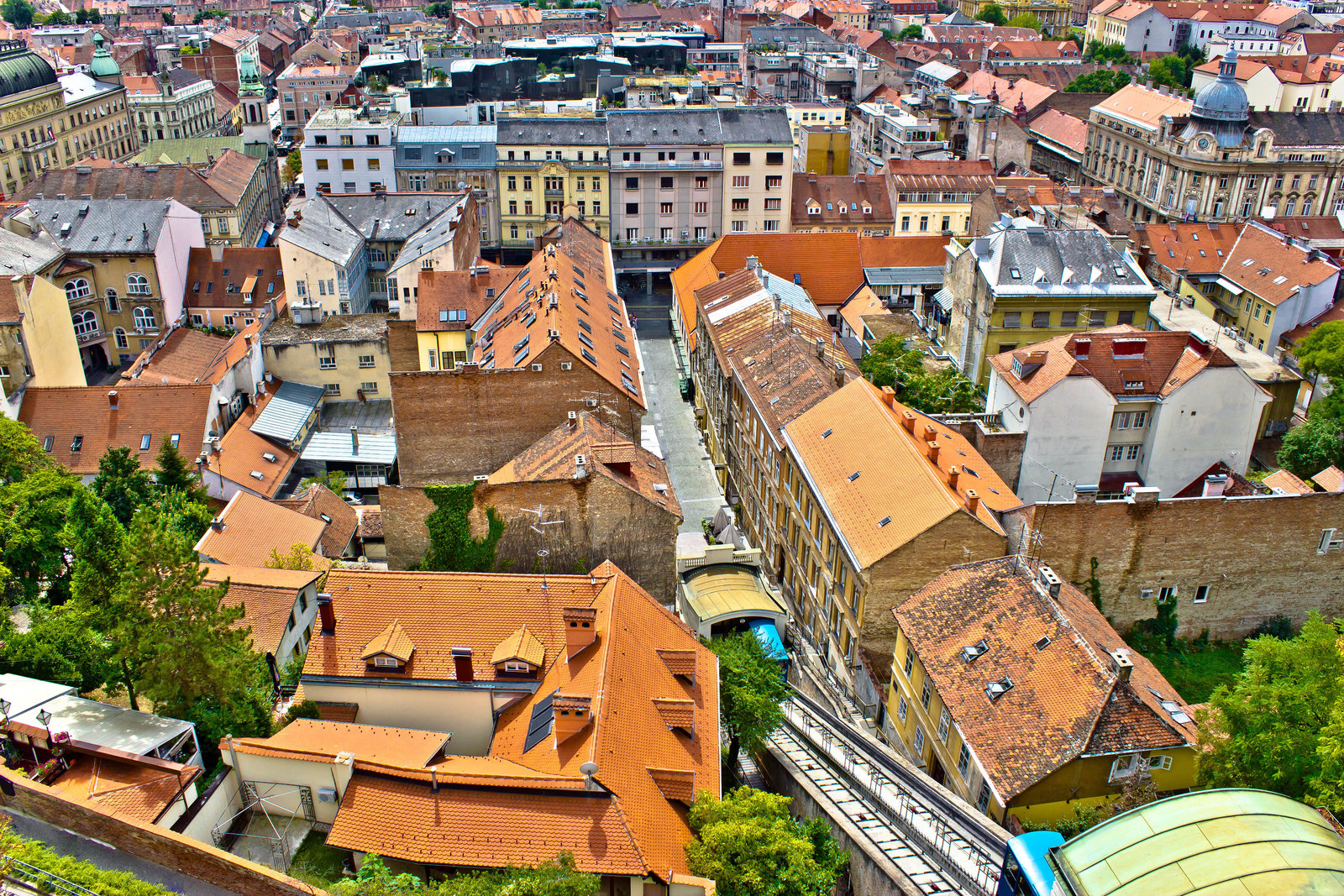
Our favourite part of the city in our opinion (and who will contest our opinion on what is our favourite, right?) The Lower town is one of the most vibrant areas in this charming European city. Here visitors will find a colorful array of shops, restaurants, art galleries, and historical attractions.
Want to experience it with a guide on top of a bus? Check this tour out.
With a rich cultural heritage steeped in history and tradition, the Lower town makes for an unforgettable getaway.
The area stretches from the bustling main square Trg Bana Josipa Jelacica to the iconic St Mark’s Church.
This lively square is home to numerous eateries serving up local delicacies such as cevapi and strukli, while artistically-inclined folks can browse a variety of art galleries and antique stores along Ilica Street.
Brief History
Lower Town has a captivating history worth exploring. It is located in the heart of Croatia’s capital and dates back to medieval times.
The area is full of cobblestone streets, colorful buildings, and historic sites that tell the story of Zagreb’s past. From ancient churches to museums and parks, visitors can learn about the city’s rich history by taking a stroll through the capital’s Lower Town.
The area was first established in the 12th century when King Ladislaus founded the city below Mount Medvednica. In 1645, it was granted its own coat of arms by King Ferdinand III and it became an important trading hub for many centuries to come.
3 fun facts about Zagreb`s lower town
- If an aerial view was taken of the city, you would observe a horseshoe shape composed of eight green spaces aligned squarely with the city’s boundaries.
- A number of the historic landmarks in the town are located in the Green Horseshoe area, such as the Croatian National Theatre, which works as a theater, opera, and ballet facility.
- Thus, if you’re interested in quickly and easily exploring the beautiful city of Lower Town and admiring the wonderful historical structures therein, I recommend walking through the rest of the citywide parks network.
Zagreb Cathedral
10000, Zagreb, Croatia || every day 10 a.m. – 5 p.m. on Sundays and holidays from 1 p.m. – 5 p.m
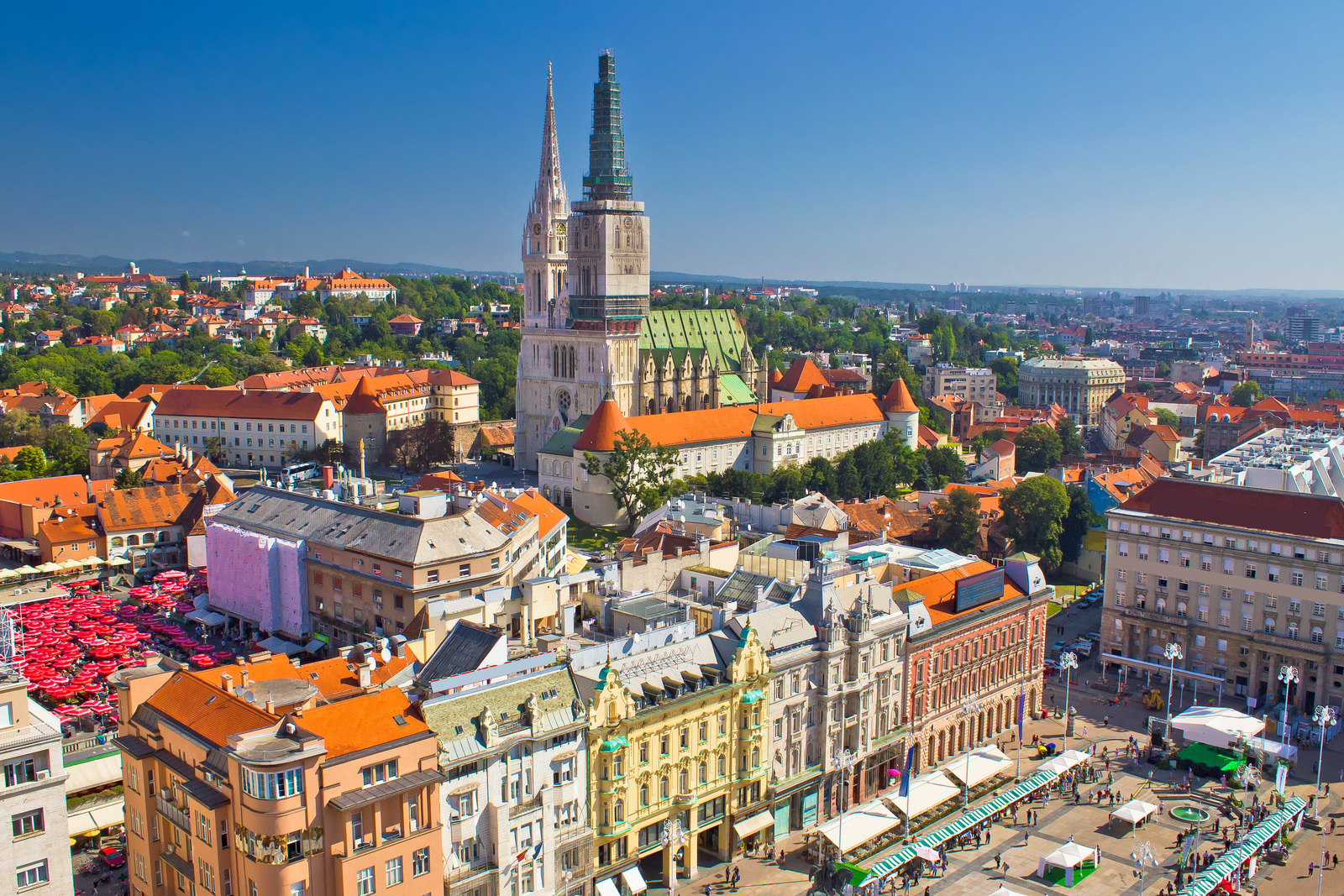
The Cathedral is one of the oldest and most iconic landmarks in the country and one of the best things to see in Zagreb.
This Roman Catholic church was built in the mid-13th century and stands as a symbol of the city’s religious heritage.
With its distinctive spires, this structure dominated Zagreb’s skyline for centuries. Inside, visitors meet with a stunning display of religious artwork, including frescoes and stained glass windows that date back to the 15th century.
The cathedral also contains several tombs of important figures in the country`s history.
The architecture of the capital’s cathedral is unique and impressive, featuring ornate Baroque-style detailing on its two towers that rise over 80 meters above the city. Its interior features columns made from pink stone which contrasts with white marble accents throughout its walls and ceilings.
Brief History
The cathedral dates back to medieval times when it was constructed in 1093 by King Ladislaus I. But its current appearance dates back to the 19th century when major renovations were carried out.
The construction of the cathedral spanned over the course of several centuries and underwent various changes throughout its long history.
For example, in 1242 two Gothic towers were added on either side of the entrance, while later in 1731 Baroque decorations were added. In the 1880s extensive renovation works took place which included replacing some parts with Neo-Gothic elements such as pinnacles and small statues around windows and doors.
3 fun facts about Zagreb`s cathedral
- The cathedral in Croatia is the tallest structure in the country!
- The organ is recognized as a landmark monument of culture at the Ministry of Culture of the Republic of Croatia.
- If you plan on taking a trip to Zagreb during the summer, do not miss the organ festival.
Dolac market
Dolac 9, 10000, Zagreb, Croatia || from Monday to Friday 6:30 AM – 2 PM Saturday 6:30 AM – 3 PM Sunday 6:30 AM – 1 PM
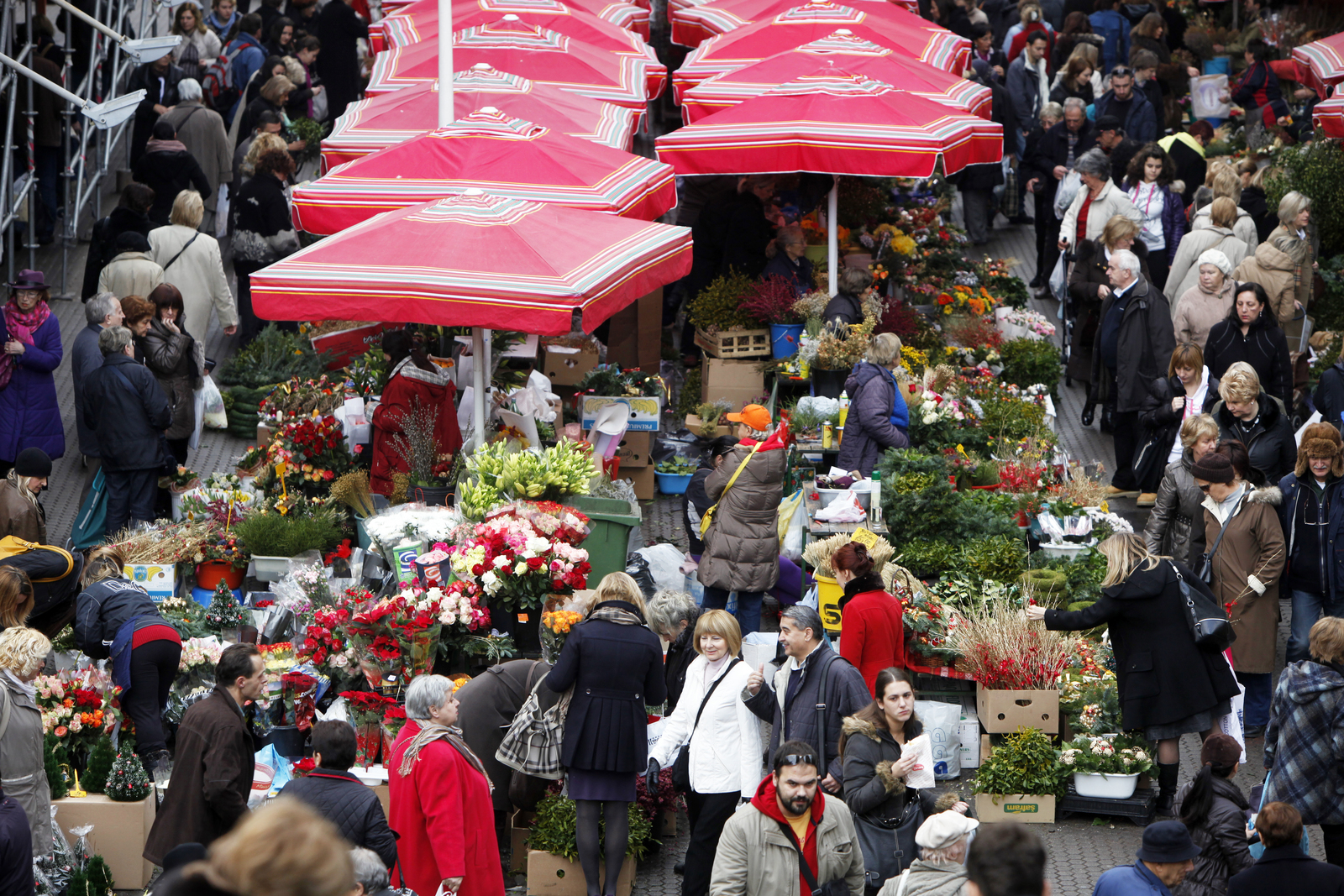
Capital’s Dolac Market is a vibrant and bustling place to explore. Located in the center of Zagreb, it is one of the country’s most well-known and popular tourist attractions.
The aroma of fresh flowers, fruits, and vegetables fills the air as you walk through this vibrant market. It also offers an insight into the traditional country`s culture with its local produce, souvenirs, and crafts.
This bustling marketplace has something for everyone – from local delicacies such as čokoladna torta (chocolate cake) to traditional handicrafts like embroidered tablecloths and lace doilies. Whether you’re looking for fresh fruit, spices, or souvenirs, there is something to suit every taste at Dolac Market.
You can even find fresh seafood that was caught just off the coast of the capital – guaranteed to be some of the freshest around!
Brief History
The Dolac Market is an iconic spot for locals and tourists alike.
This historic market offers fresh produce, seafood, meats, and cheeses from local farmers and vendors. It is also home to a variety of other unique goods such as cultural crafts, souvenirs, and jewelry.
Dolac Market was established on the west side of the capital’s Old Town in 1930 after King Alexander I ordered its construction during his visit that year. Since then, it became one of the city’s most important markets with more than 800 vendors selling everything from fruits and vegetables to traditional Croatian delicacies like ćevapčići (meat sausages).
3 fun facts about the Dolac market
- The Dolac neighbourhood, before it was a market, was a very poor area.
- Its unique design and large umbrellas make it easy to see.
- From the opening on, women selling products went there with fresh fruits and vegetables, flowers, and meat. You could do nothing but be friendly to your kumica to go back to her and obtain the best products. Consider simply extending a friendly Croatian greeting to him or her!
War Photography Museum
Ul. Andrije Hebranga 4, 10000, Zagreb, Croatia || every day 10 AM – 4 PM
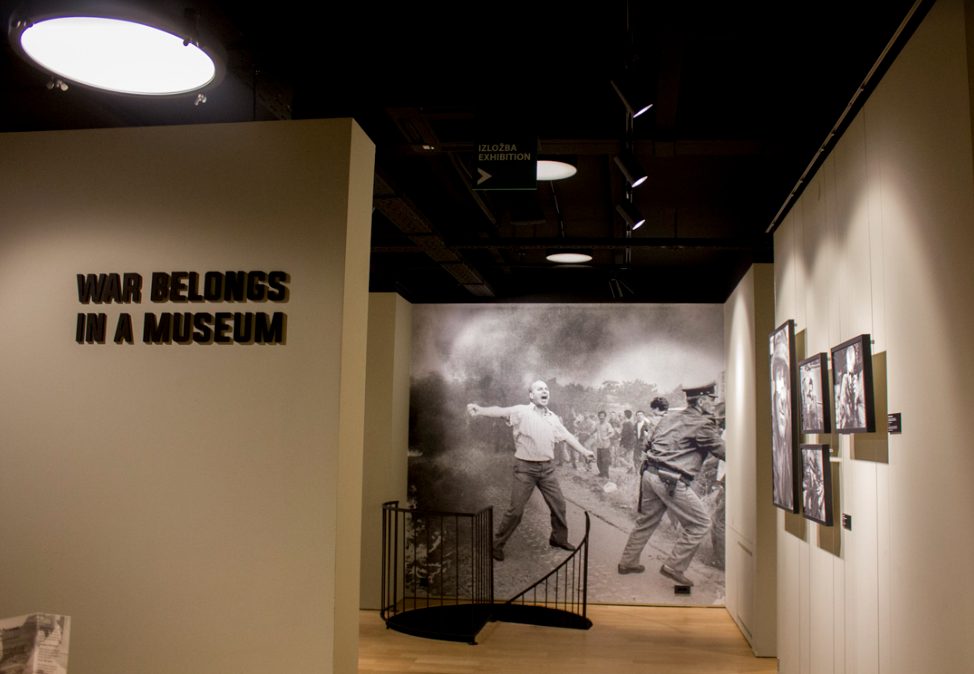
The War Photography Museum in Zagreb, Croatia is an incredible display of the horrors and triumphs of war. It’s one of the top Zagreb attractions.
If you’re looking for a tour to experience the 90s war, check this 2,5 hour guided tour here. It’s going to show you every glimpse into the long and arduous war Croatia was in.
It brings together a decade’s worth of photography to create a unique and thought-provoking experience for visitors.
Since opening in 2017, the museum hosted thousands of tourists and locals alike, sharing powerful stories through the photographs on display.
Through these photos, viewers gain insight into both sides of the war – those who are fighting it and those who are affected by it. The pictures tell stories that range from heroic acts to devastating losses and bring to life the full spectrum of experiences endured during conflict.
Visitors can explore images from all over the world including World War I, II as well as various conflicts since then. The museum also features special events like lectures on war photography or seminars about its impact on society today.
Brief History
The War Photography Museum is a unique and memorable experience. The museum was created to honor the photographers who bravely documented the conflicts, wars, and political upheaval that occurred during the 20th century.
The museum also serves as a reminder of how far human beings have come since then – not only technologically but also morally and ethically – by documenting atrocities and acts of courage alike.
In addition to displaying these powerful images, the War Photography Museum also provides educational programs for children and adults on topics related to war photography such as ethics and photojournalism.
3 fun facts about War Photography Museum
- Firstly, the museum houses more than 25,000 pictures taken during different wars since World War I up until present-day conflicts.
- Secondly, this museum does not only include war-related photos but also hosts special exhibitions throughout the year to celebrate female photographers and their work in conflict zones.
- This extensive collection allows visitors to gain insight into various time periods and understand how the war changed over time.
The Modern Gallery
Ul. Andrije Hebranga 1, 10000, Zagreb, Croatia || Monday – closed from Tuesday to Friday 11 AM – 7 PM Saturday and Sunday 11 AM – 2 PM
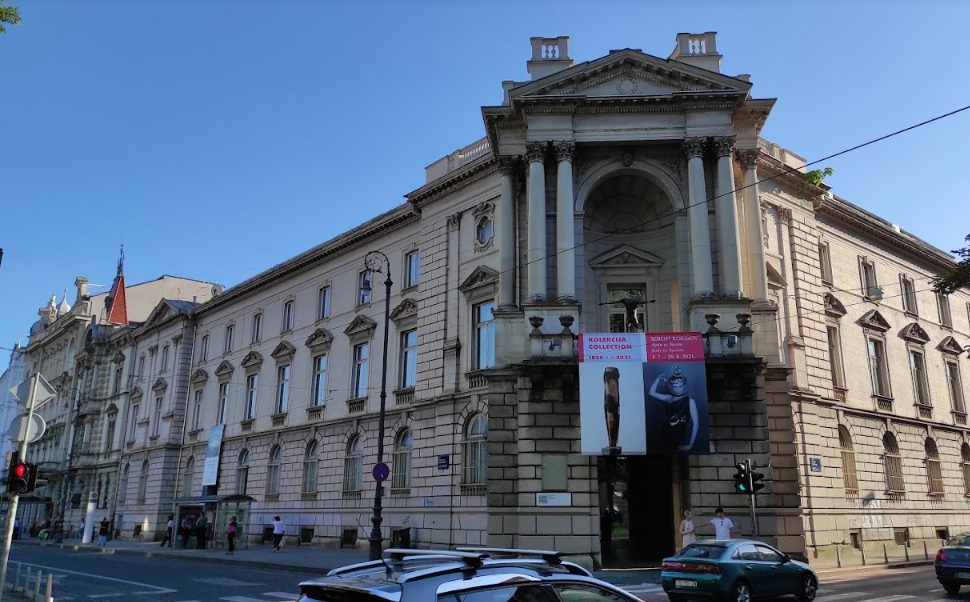
Modern Gallery Zagreb is an award-winning contemporary art space located in the capital of Croatia. Dates from the early 1900s, the gallery strives to exhibit works of cutting-edge artists from around the world and promote Croatian contemporary art to a global audience.
The start-of-the-art facility has 10 exhibition spaces, two sculpture courtyards, and a library with over 8,000 volumes on modern art theory.
The gallery aims to provide visitors with an immersive experience through its special exhibitions featuring established and emerging international artists such as Marina Abramović, Anish Kapoor, and Ai Weiwei.
Additionally, Modern Gallery Zagreb offers educational programs for students where they can learn about different art movements past and present. It also hosts talks from notable figures in the world of art so everyone can have access to new ideas and perspectives on today’s artistic landscape.
Brief History
Modern Gallery Zagreb is a renowned Croatian art gallery that was operating since 1905.
It was founded by the Croatian artist Vlado Kristl, who sought to create an institution dedicated to the promotion of modern and contemporary art in Croatia.
In its beginnings it was a small gallery, exhibiting works from local artists, most of whom were members of the Yugoslavian avant-garde scene. Throughout its 75-year history, Modern Gallery Zagreb grew significantly and today it is one of Croatia’s leading visual arts institutions.
The gallery showcases both Croatian and international artists from all over Europe and beyond, including many renowned 20th-century masters such as Picasso, Duchamp, Kandinsky, and Klee.
3 Fun Facts About Zagreb`s Modern Gallery
- First, MGZ has an impressive collection of over 4,000 pieces of art.
- This includes famous works by renowned Croatian artists such as Ivan Meštrović, Oton Iveković, Mladen Večerina, and others.
- Additionally, it houses some international pieces by world-renowned artists like Salvador Dali.
Zagreb Botanical Garden
Trg Marka Marulića 9A, 10000, Zagreb, Croatia || Monday and Tuesday 9:00 AM – 2:30 PM from Wednesday to Sunday: 9:00 AM – 7:00 PM
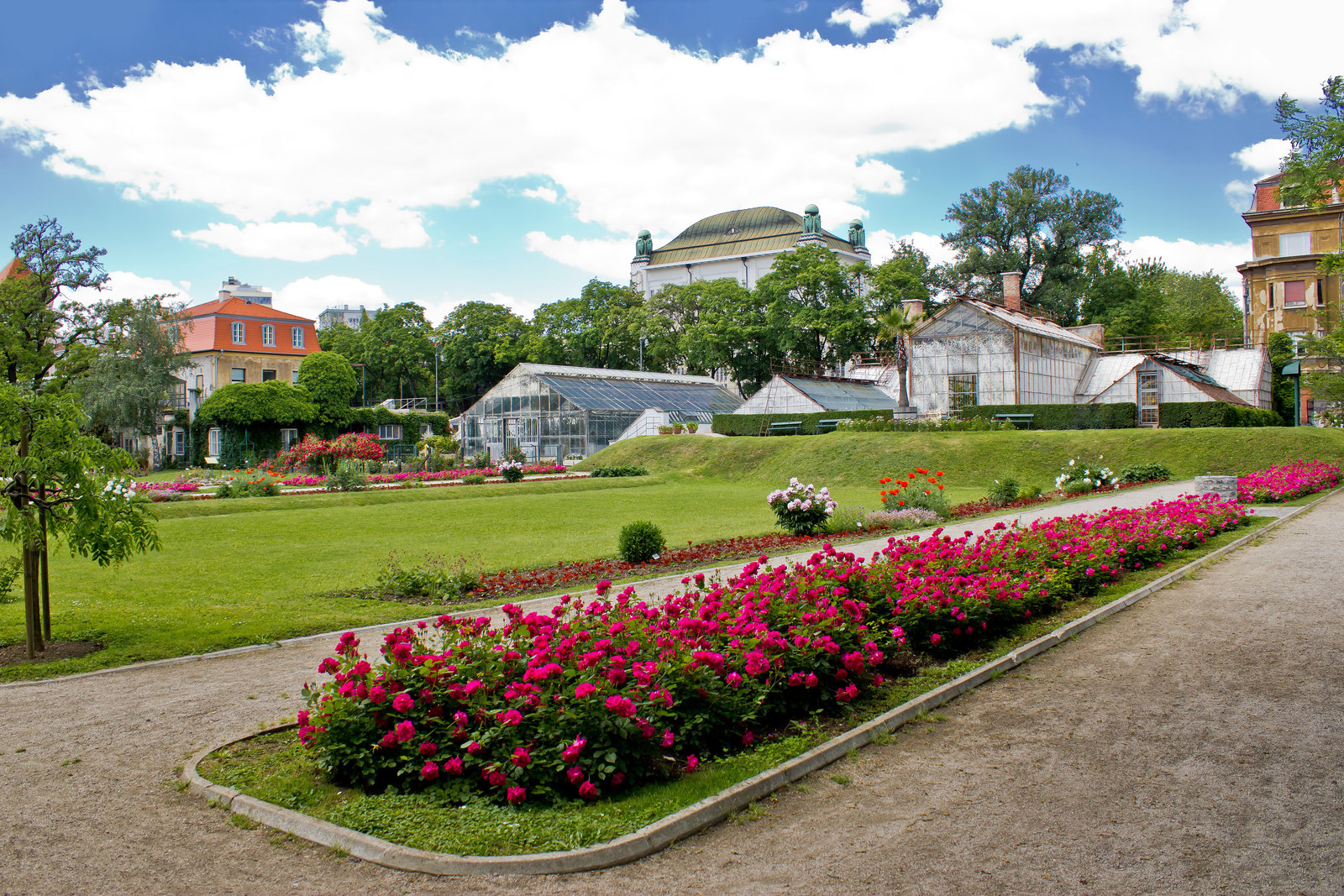
Zagreb is home to one of the most beautiful botanical gardens in the world. It’s one of the attractions that is a must see in Zagreb.
It’s located in Maksimir Park and was founded in 1889 by a group of local botanists. This 5-hectare garden has over 10,000 species of plants from all around the world, making it one of the most diverse collections anywhere.
Visitors can explore a variety of environments from tropical rainforests to cactus deserts on walking paths throughout the garden.
The gardens also boast a number of educational programs designed to help visitors learn about different species and their habitats.
They also host special events such as concerts and workshops for children and adults alike. With its stunning landscape and interesting activities, it’s no wonder why this living museum is a popular destination for locals and tourists alike.
Brief History
The city of Zagreb is home to an array of beautiful and historic landmarks. One such landmark is the Botanical Garden. This garden offers visitors a glimpse into its rich history.
Established by botanist Antun Heinz, the Botanical Garden was initially called the Royal Botanical Garden as it was created for royal purposes by decree of Austrian Emperor Franz Joseph I.
It was also part of the University of Zagreb’s Department Of Natural Sciences and Mathematics until 1920 when it became an independent institution. Over time, more land was acquired to expand the gardens and eventually they encompassed over 10 hectares with an abundance of flora including trees, flowers, shrubs, herbs, and cacti from all over the world.
3 fun facts about Zagreb`s Botanical Garden
- The bulk of the garden is taken up by the arboretum.
- Crops used for research, development, and inventions are grown in 14 greenhouses.
- The flower garden containing ornamental herbaceous plants and roses, located west of the glasshouses in the Garden, is constructed in the French style that features strict geometrical lines.
Zagreb`s Main Square
10000, Zagreb, Croatia || every day open 24 hours
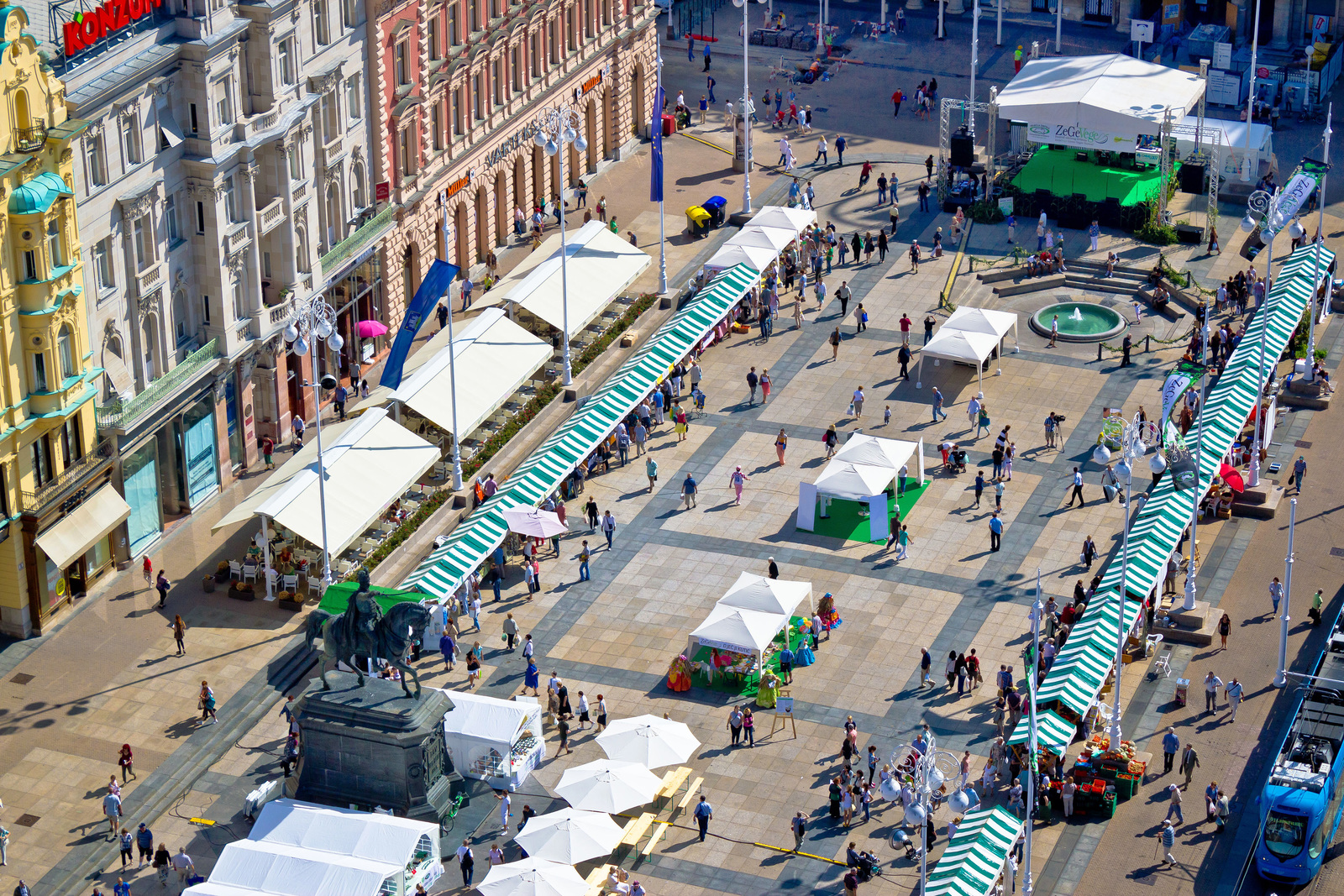
Zagreb’s Main Square is the largest, most vibrant, and bustling public square in all of Croatia (You’d expect that given the fact that it’s the biggest city and all) Located in the heart of Zagreb, it is a hub for locals and tourists alike. People come here to shop, sightsee, grab a bite to eat, or just take in the atmosphere.
The Main Square holds some of Croatia’s most famous monuments such as St Mark’s Church and its distinctive tiled roof. Other attractions include museums, galleries, cafes, and plenty of outdoor seating – ideal for people-watching. In addition, there are several fountains that provide a great backdrop for photos or simply enjoying a moment of peace on your visit to this historic city centre.
A lively atmosphere prevails throughout the day with lots of street performers regularly gathering at the square to entertain passers-by; making it an entertainment destination as well as an educational one.
Brief History
Zagreb’s main square has a long and varied history, tracing its roots to 1641. It was originally named Dorna Trg, or “Door Square,” as it was located near the entrance of a city gate. The name changed in 1848 when Austrian authorities renamed it Ban Jelacic Square after the Croatian Ban Josip Jelacic. For more than 100 years, this expansive cobblestone plaza served as Zagreb’s central gathering area for festivals, protests, and other civic events.
In 1947, Ban Jelacic Square was officially given its current name – Trg Bana Jelacica (Jelacic Square). The square underwent several renovations over the course of the twentieth century to make room for monuments honoring Croatia’s independence struggle and war heroes.
3 fun facts about Zagreb`s main square
- Tourists toss coins into the fountain for luck.
- The square was the main marketplace of Zagreb and was figuratively called the Harmica square (Hungarian for 1/3), after the rate on the merchandise sold here.
- The most popular meeting locations are next to the bronze statue of Ban Jelacic in the center, and beside the horse’s tail, which is a reference to the equestrian statue located in the centre of the square.
The Maksimir Park
Maksimirski perivoj 1, 10000, Zagreb, Croatia || every day open 24 hours
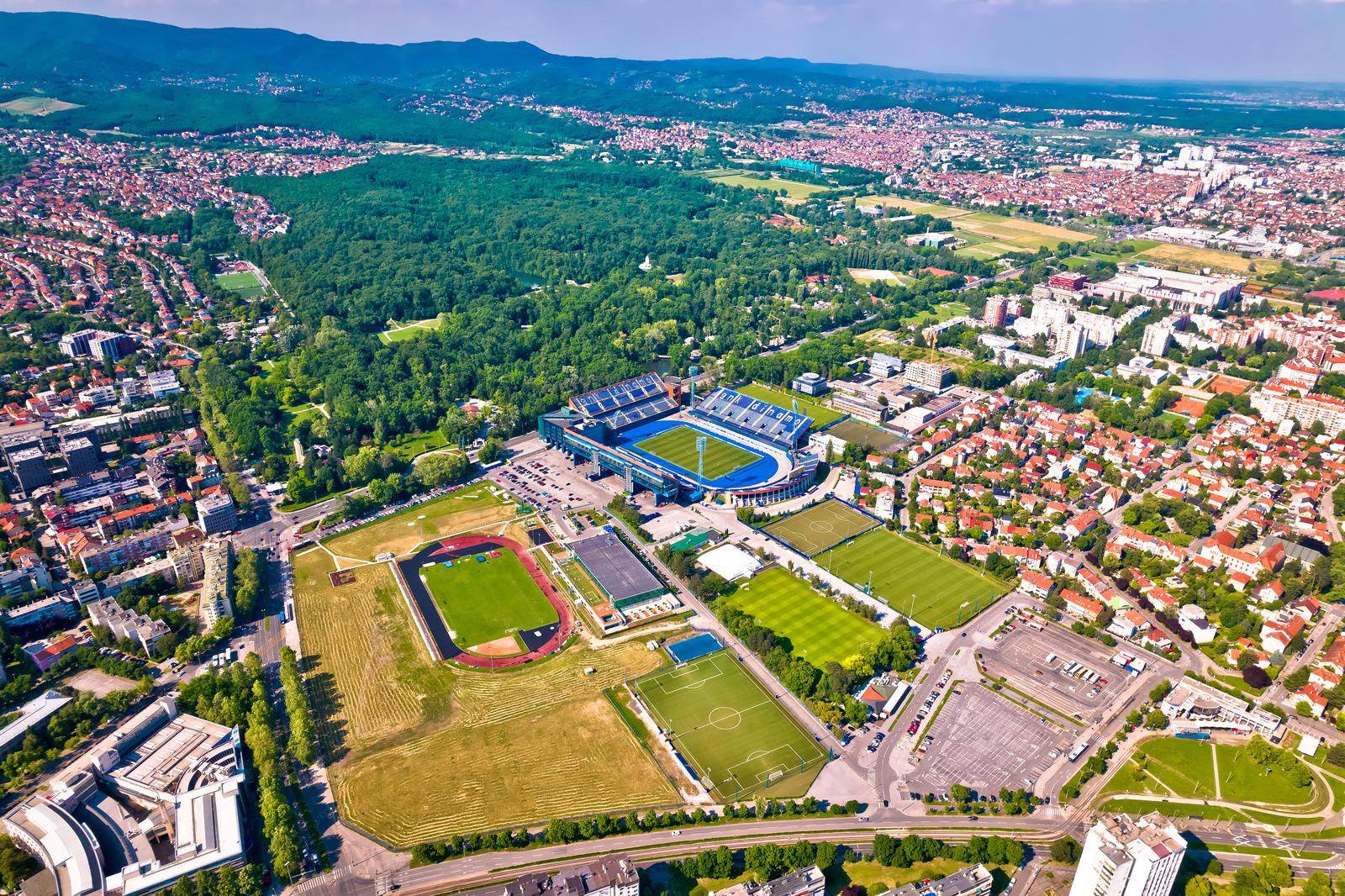
Maksimir Park in Zagreb is one of the oldest and most beloved parks in Croatia.
The park was opened to the public in 1787, making it over 230 years old. It is located on the eastern side of Zagreb and covers an area of 316 hectares (860 acres). Maksimir Park offers visitors a variety of activities such as cycling, jogging, walking paths, and playgrounds for children. There are also plenty of benches to enjoy the beautiful nature that surrounds the park.
The park is home to many different species of animals including foxes, deer, boars, and birds such as swans, ducks, and even peacocks! Furthermore, there are numerous monuments located within Maksimir Park ranging from sculptures to memorials that commemorate important moments in Croatia’s history.
Brief History
The core of the park consists of two large meadows interconnected by a network of pathways lined with chestnut trees. It also features several lakes used for fishing and boating activities; one contains an island that was home to many species over its long history.
3 fun facts about Maksimir park
- Its name is an abbreviation of Maksimilijanov mir, meaning Maksimilijan`s peace.
- The park is home to over 100 species of birds that nest in holes.
- It is nice for runners who are searching for a versatile combination of gravel, paved roads, and trails that are surrounded by tall trees, small lakes, ponds, and meadows.
Maksimir Stadium (Iconic Attraction)
Maksimirska cesta 128, 10000, Zagreb, Croatia
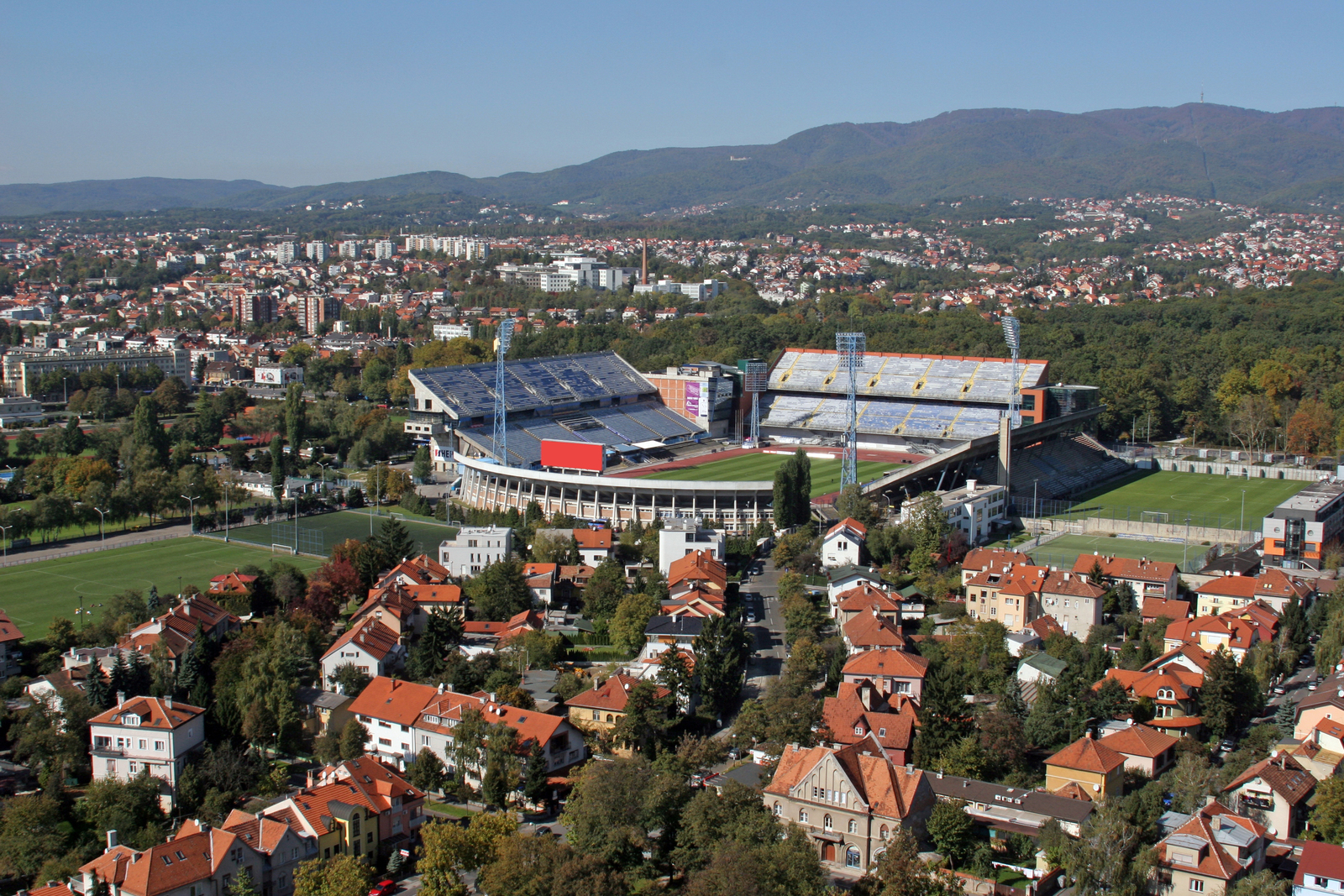
Maksimir Stadium in Zagreb is one of the oldest football stadiums in Europe.
Built-in 1912, it has a long and rich history. Located within Maksimir Park, it remains the largest stadium in Croatia and home to the country’s most popular football club, Dinamo Zagreb.
The stadium initially housed only two stands with seating for 4,000 spectators. However, over time its capacity was increased to 38,500 due to frequent renovations and expansion projects throughout the years.
It played host to some of Europe’s biggest games such as the UEFA Cup Winners’ Cup finals between FC Barcelona and Ferencváros TC.
Apart from hosting major international competitions and local football leagues, Maksimir Stadium is also used for concerts by renowned international artists like Metallica and U2.
Brief History
Maksimir Stadium was home to many domestic and international football matches since its opening in 1912. The stadium was built as a part of Maksimir Park, which was designed by Hermann Bollé who also worked on Vienna’s Prater Park.
The stadium seats 35,000 spectators and is the main venue for Dinamo Zagreb, Croatia’s most successful football team. It played host to a number of prestigious tournaments such as Euro 1996 qualifiers and World Cup 1998 qualifiers where some of Europe’s biggest teams like Germany and England competed for glory. The stadium also hosted several UEFA Champions League matches over the years including a memorable match between Arsenal and Barcelona which ended 4-2 in favour of Barcelona.
3 fun facts about Maksimir stadium
- The venue sometimes welcomes plenty of other events, such as rock concerts.
- The venue was also used to hold a number of well-known concerts, including by Dire Straits, David Bowie, U2, Madonna, Depeche Mode, and Robbie Williams all held concerts at the stadium.
- Stadium Maksimir contained mostly terraces when Stadium Maksimir was present after the end of the Second World War.
Zagreb`s National Theatre
Trg Republike Hrvatske 15, 10000, Zagreb, Croatia
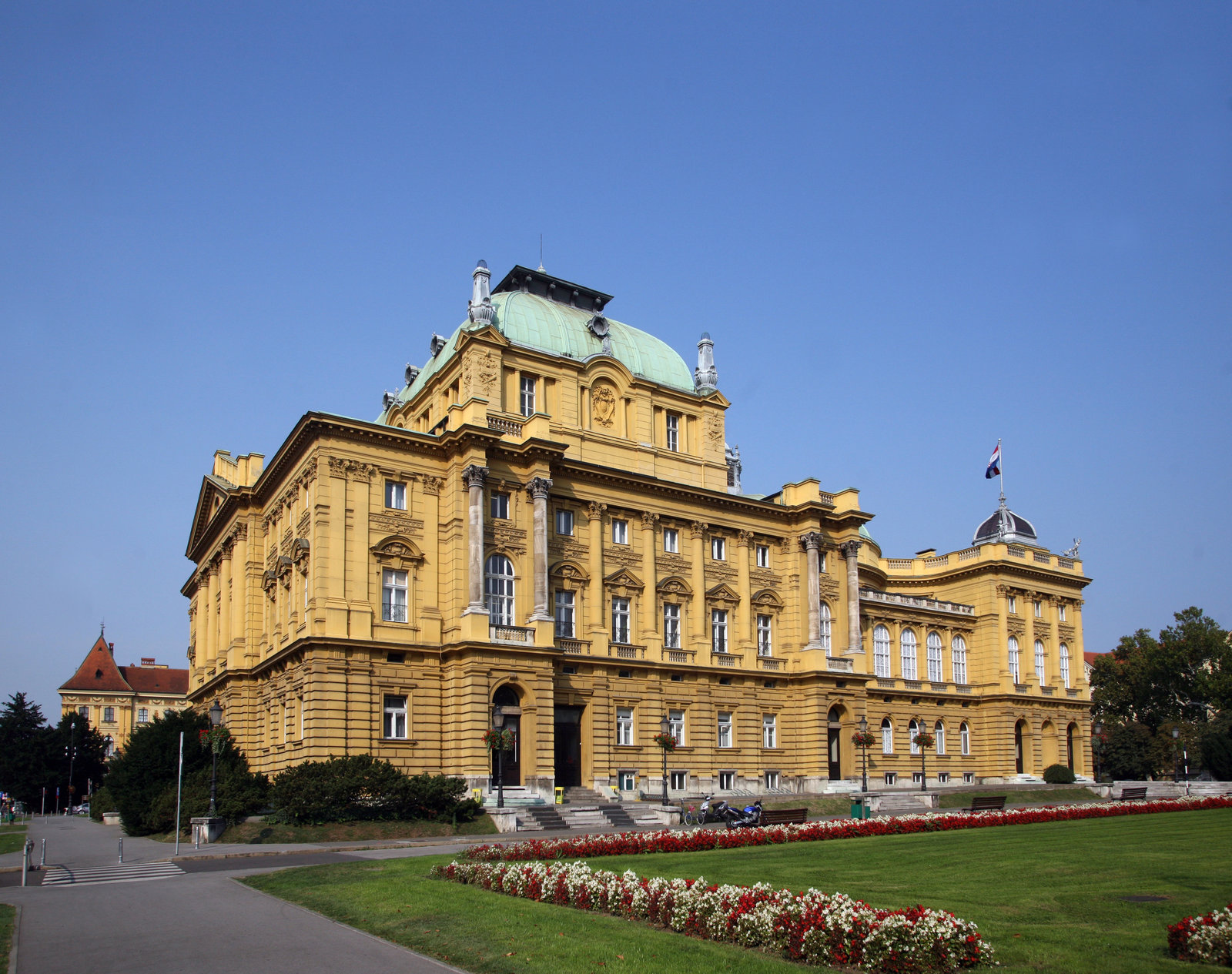
Zagreb’s National Theatre is a cultural landmark in Croatia. It first opened its doors to the public in 1895 and since then was an important artistic hub of the city.
It offers a wide variety of performances ranging from operas and ballets to plays, concerts, and other live events.
The theatre is home to some of Croatia’s best actors, singers, dancers, directors, and musicians. It houses two stages including a large main stage with over 715 seats as well as a smaller experimental stage for more intimate performances.
In addition to showcasing world-class talent from Zagreb and beyond, visitors can also enjoy guided tours through the historical building that takes them back in time to explore its rich history.
Brief History
Zagreb’s National Theatre has a long and vibrant history.
Established in 1860 through the efforts of Croatian dramatists who wanted to stage works written by Croatians, it was the first professional theatre in Croatia and one of the oldest theatres in Europe.
It quickly became a beloved institution by Zagrebians and tourists alike, hosting performances of both classical and modern works from some of the greatest playwrights in history.
The National Theatre continues to be an integral part of Zagreb’s cultural life today, drawing thousands of visitors each year with its impressive repertoire featuring everything from opera to ballet and drama. The building itself is noteworthy for its beautiful neo-Baroque design which still stands out amongst the rest of downtown Zagreb’s architecture.
3 fun facts about Zagreb`s National theatre
- There are roughly three theaters with the same name in Croatia that are located in Zadar, Varazdin, and Sibenik.
- There are over 230 stage productions each year, including at least twelve debuts, twenty reruns, and other productions.
- The Croatian National Theatre in Europe is a member of The European Organization Opera Europa.
How to Get To Zagreb, Croatia? Mile Answers
Ah, the marvelous Zagreb, Croatia’s charming capital, where history meets modernity, and cobblestones echo with the steps of the curious traveler. But how does one get to this Balkan beauty? Hold on to your šljivovica, for I shall enlighten you!
First, let’s tackle the skies! Flap those wings and fly into the Franjo Tuđman Airport (ZAG), Zagreb’s grand gateway. Here, you’ll find numerous airlines connecting our Croatian jewel with major European hubs and some cities beyond. For the savvy explorer, low-cost carriers can be your wallet’s best friend.
Now, for the land-lovers. Fear not, as the iron steeds of Europe will whisk you to Zagreb! Trains glide seamlessly through the picturesque countryside, crossing borders with ease. From cities like Vienna, Budapest, and Ljubljana, you’re just a scenic chug-chug away. Don’t forget to take a gander at those splendid views!
If the open road beckons you, hop onto one of Europe’s well-connected highways. Zagreb lies at the crossroads of several major routes, so saddle up your trusty four-wheeled steed and set forth on your asphalt adventure. Pro tip: Keep some kunas handy for those pesky tolls.
In 200 words or less, I say: fly, ride or drive – just make haste to the enchanting embrace of Zagreb
How To Get Around Zagreb? Mile Answers
Ah, so you’ve arrived in the embrace of Zagreb, that delightful Croatian capital! Now, let’s traverse its splendid streets and navigate its nooks with the wisdom of a local. Fasten your fanny packs, for we’re about to embark on a witty whirlwind tour of getting around Zagreb!
First, let’s conquer the city on foot! With the picturesque historic core, the pedestrian-friendly streets, and a hearty dose of štrukli fueling your steps, you’ll discover the allure of Zagreb’s walkability. Lace up your snazzy sneakers and let your two trusty limbs carry you through history and hipsterdom alike!
Should you tire of pedestrian gallantry, fear not! Zagreb’s public transport network, ZET, will save the day. With trams zipping through the city like vibrant caterpillars, you’ll never be far from a smooth ride. Buy a ticket, validate it aboard, and voilà! Zagreb is your oyster. For the truly adventurous, buses might be your cup of Croatian tea.
Craving a more personalized steed? Rent a bike or summon a taxi, but beware the latter’s potential for mischief. If hailing a cab, keep your wits about you and ensure the meter’s running.
To sum it up, my friend: walk, tram, bus, bike, or taxi – Zagreb’s at your disposal. Just remember to pack your sense of adventure and a hearty appetite for exploration!
Day Trips From Zagreb
Where To Stay In Zagreb? Mile Answers
So, you’ve made it to Zagreb, that beguiling Croatian capital, and you’re seeking a cozy nest for your weary head. Fear not, dear traveler! I shall unveil the city’s finest accommodations, tailored to every whim and wallet. Ready, set, slumber!
For the luxury-loving globetrotter, look no further than the city center’s opulent hotels, where glamour and grandeur abound. From the illustrious Esplanade Zagreb, where Orient Express passengers once laid their hats, to the chic Hotel Le Premier, your every wish shall be granted. Revel in the lap of luxury, you magnificent wanderer!
Should your pocketbook prefer prudence, boutique hotels and charming guesthouses await. With style and personality aplenty, these gems like Hotel Jägerhorn or Swanky Mint Hostel offer a delightful mix of comfort and character. Rest assured, you’ll sleep like a Croatian king on a shoestring budget.
And for the social butterflies and penny-pinchers, hostels are your haven. Rub elbows with fellow wayfarers and share tales of adventure at lively establishments such as Chillout Hostel or the Wallaby House. Friendships and memories are but a bunk bed away!
In short, whether you desire decadence, character, or camaraderie, Zagreb’s got you covered. So choose your dwelling, tuck in for the night, and dream of tomorrow’s adventures in this enchanting city. Sweet dreams, traveler!
Additional Questions Travellers Ask Mile (Incessantly)
Is Zagreb worth visiting?
Absolutely! Discover treasures like St. Mark’s Church, adorned with its vibrant tiled roof, or the quirky Museum of Broken Relationships. Explore bustling markets, feast on divine cuisine, and savor the city’s vibrant spirit. Zagreb may not have the fame of Paris or Rome, but this underdog will steal your heart with its unique allure.
Is 2 days enough in Zagreb?
Ah, two days in Zagreb – it’s like sipping an espresso instead of leisurely savoring a cappuccino! Can it be done? Absolutely! But, my dear traveler, prepare for a whirlwind dalliance with this captivating Croatian capital.
Day one, storm the Upper Town with its medieval magic – St. Mark’s Church, Lotrščak Tower, and quaint cobblestone streets. By evening, immerse yourself in the city’s gastronomic delights.
Day two, conquer the Lower Town’s museums, galleries, and parks. Don’t miss the quirky Museum of Broken Relationships, and end your day with a vibrant sunset at Zrinjevac Park.
Two days, a fleeting affair – but Zagreb will forever hold a place in your heart.
How can I have fun in Zagreb?
Oh, fun in Zagreb? Prepare for a rollicking good time, my adventurous amigo! Begin by exploring the city’s vibrant street art and hidden gems.
Embrace the café culture with a cup of kava and people-watching. Get lost in the bustling Dolac Market, where fresh produce and local delicacies await. Dance the night away in a lively club or sway to the tune of live music at a cozy pub. Unwind in the lush parks or atop the Sljeme mountain. In Zagreb, fun is around every cobblestone corner, waiting to sweep you off your feet!
Where to party in Zagreb?
Party animals, rejoice! Zagreb’s nightlife scene is a thrilling dance floor of possibilities! Start by prowling the streets of Tkalčićeva, a bustling artery of bars, clubs, and pubs.
Seek out Vinyl, where nostalgia and craft beers collide, or peek into Alcatraz for a gritty, industrial vibe. For a bass-thumping, strobe-lit affair, boogie on over to clubs like Opera or Katran.
If alternative beats call your name, Močvara and Medika are your edgy havens. Remember, when the sun sets in Zagreb, the nocturnal creatures come out to play – so strap on your dancing shoes and join the revelry!
Best Things To Do In Zagreb, The Croatian Capital: Last Words
Ah, Zagreb, the Croatian capital, a delightful potpourri of history, culture, and merriment! To distill its essence into a mere 150 words is a challenge worthy of the wittiest of wordsmiths, but fear not, for I shall do my best.
Commence your Zagrebian escapade in the Upper Town, where medieval charms and historic gems like St. Mark’s Church and Lotrščak Tower enchant and beguile. Descend into the Lower Town to indulge in a sumptuous buffet of museums and galleries, including the quirky Museum of Broken Relationships.
There are literally unlimited attractions in Zagreb to see.
Satiate your inner epicurean with gastronomic delights found in bustling markets or chic eateries, where culinary creations like štrukli will have your taste buds singing praises.
Immerse yourself in the vibrant street art, the soul-soothing parks, and the bustling café culture that breathes life into the city’s cobblestone veins. And when night falls, prepare to dance with the nocturnal creatures of Zagreb’s eclectic nightlife scene.
In conclusion, my dear wanderer, embrace the multifaceted spirit of Zagreb, for it is a city that will sweep you off your feet and leave you yearning for more. In the words of the locals, “Dođi, uživaj i neka ti srce zaigra!” – “Come, enjoy and let your heart dance!”
Looking for a more business like guide to Croatia? Check out our Digital Nomad Guide To Croatia.
Visit Zagreb! Or Find Out The Best Places To Visit In These Balkan Cities
If you’re traveling to Belgrade, check out our things to do in Belgrade article!
Traveling to Sofia, Bulgaria instead? Here’s an in-depth guide to the best things to do in Sofia!
Maybe even Skopje? Check out our guide on the essential things to do in Skopje!
Or, visit the neighbours over at Bosnia, and find out about the best things to do in Sarajevo!
How about visiting Montenegro and seeing the best things to do in Podgorica, the capital?
Last but not least, here’s our guide on the best things to do in Ljubljana!
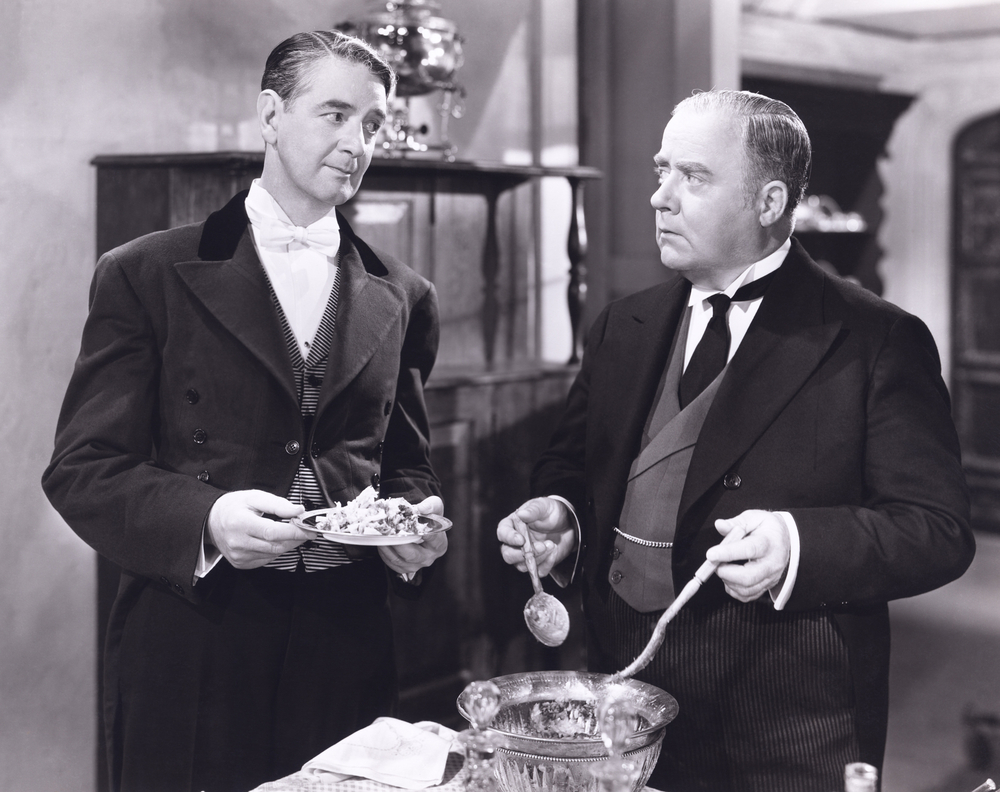
Avid travelers, passionate fishermen, and all-around great guys to hang out with (therefore the reason why they are the ones traveling around and not the rest of us, introverts and repulsive individuals). When not writing about their latest trip or catch, they drink beer, play the synth and call their friends to unpurposefully annoy them. A lot.